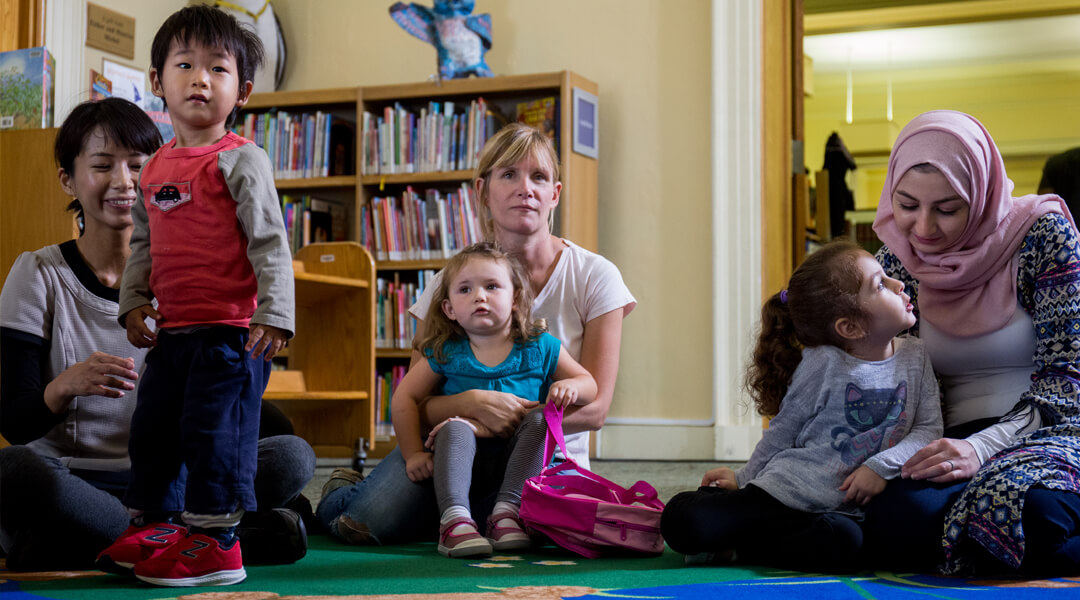
Six Early Literacy Skills
When you do any of the five Early Learning Activities (Talk, Sing, Read, Write Play) with your child, you are building early literacy skills! The six early literacy skills help your child to learn to read in Kindergarten and beyond. Here are some ideas about what you can do to build the six early literacy skills with your child.
Vocabulary is knowing the names of things.
With babies (birth-18 months), help them “act out” different vocabulary to build a body-memory connection between a word and its meaning.
With toddlers (18 months-36 months), make direct connections between real life examples of words you read. For example, when you read a book with umbrellas in it, point out an umbrella the next time you see one and connect it back to the book.
With preschoolers (3-5 years old), approach picture book language with curiosity and excitement. In other words, don’t skip more complex words like “sneaky”, “illuminate” or “excavate”. Many picture books use vocabulary that is not part of common conversational language and reading it helps expand vocabulary.
Print Motivation is having interest in and enjoyment of books.
With babies (birth-18 months), seek out board and tactile books with flaps. When books seem like “toys” or are fun because they have different parts to manipulate, your child will build a positive relationship with books.
With toddlers (18 months-36 months), find books with real images and illustrations that share diverse identities. When children see themselves along with people who don’t look like them in books, they will feel like they belong with books and reading while building empathy for all people.
With preschoolers (3-5 years old), pause when reading to pay attention to what your child is noticing. Talk about what they are interested in, and see where the conversation goes. This might mean you don’t make it through the whole book, and that is okay!
Print Awareness is knowing the printed word has meaning.
With babies (birth-18 months), when you find a word like “snuggle”, run your finger under the word, say the word, and then give your child a snuggle. This will signal that the printed word carries meaning, even early on!
With toddlers (18 months-36 months), point out print everywhere you see it! On street signs, food menus and more, show them what you are reading to make the connection between printed word and its meaning.
With preschoolers (3-5 years old), when you share a book that has text in varied colors, see if they can find the words by color name. An example would be asking them to find the “green” word if some of the text is green. This will draw your child’s attention to the words instead of the illustrations.
Phonological Awareness is the ability to work with smaller sounds in language.
With babies (birth-18 months), hold them on your lap and bounce along to rhymes or songs together. This helps give an additional signal for syllabic breaks in rhymes and songs, which are breaking down words into more digestible sounds.
With toddlers (18 months-36 months), share favorite songs or rhymes over and over. The repetition will help your child remember and celebrate the familiarity of the song and all the small sounds that make up the lyrics.
With preschoolers (3-5years old), make up remixes to your favorite rhymes together. Add new lines paired with motions that customize the rhyme to what you find fun, funny or interesting! This will also challenge you and your child to search for rhyming words together.
Letter Knowledge is the ability to identify letters of the alphabet and know they make different sounds and make up words.
With babies (birth-18 months), explore shapes of all kinds in toys, books and in the world. A young child’s growing knowledge of shapes will help them know the foundations of letters in the Roman alphabet.
With toddlers (18 months-36 months), as soon as they can grip a big crayon or drawing tool, let them scribble on unlined paper. Making scribbles and shapes will help them make letters when writing later in life.
With preschoolers (3-5years old), use the first letter of their first name as a game. Point out when you see or hear that letter throughout your day in upper and lowercase. See if your child can take the lead!
Narrative Skills involve describing sequences and events, and knowing stories have a beginning, middle and end.
With babies (birth-18 months), talk about what you are doing, even before your child is verbal. Making a “story” of your everyday activities will familiarize them with narration and story structure.
With toddlers (18 months-36 months), share a simple story together with a brief beginning, middle and end. Share it over and over and see if they can eventually predict the next piece of the story.
For preschoolers (3-5 years old), make up your own stories. The story can be about something you did today or something make believe. If your child is the main character of the story, they’ll be extra motivated to storytell with you!
